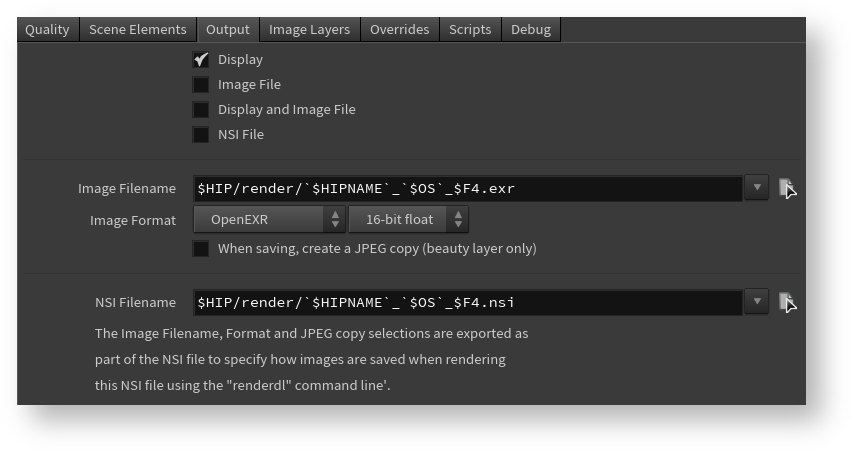The Output group
The Output group of rendering options allows you to specify what you want to be outputted as a result of your rendering command. It can be an image on your screen (viewed through 3Delight Display), an image saved on file, or an NSI file (in this case, not an image, but a 3D representation of your scene saved 3Delight's native format).
Display
Select this option to display of the image in a window on screen (viewed through 3Delight Display).
Image File
Select this option to save the image on file. The file location and format can be specified with the options below.
Display and Image File
Select this option to enable both Display and Image file.
NSI File
Select this option to just output an NSI file (or several for a sequence). With this selection, no images are actually rendered. Once the NSI file is saved, you can use the renderdl command line to render the image from this NSI file. An important benefit of rendering your images this way is that it will use significantly less memory (this is because renderdl has a very small memory footprint – usually less than half compared to rendering through the DCC application).
Image Filename
Specifies the file location for saving the image (or image layers). All default variables of the application are supported in the file name.
Image Format
Specifies the format for saving the image, including the pixel bit depth.
3Delight supports the following image file formats:
| Name & Extension | Description | Bit Depth | |
|---|---|---|---|
TIFF | .tif | TIFF format. | 8-bit integer |
OpenEXR | .exr | Open EXR format using lossless ZIP compression for all layers. | 16-bit float |
OpenEXR (DWAA) | .exr | Open EXR format using lossy DWAA compression for color layers. Layers containing data of another nature, such as normals, use lossless ZIP compression. The compression level used is the default 45, which is generally imperceptible. | 16-bit float |
OpenEXR (deep) | .exr | The Open EXR "deep" image format. Each pixel can contain multiple values at different depths. | 16-bit float |
PNG | .png | PNG format. (Single layer output only.) | 8-bit integer |
JPEG | .jpg | JPEG format. (Single layer output only.) | 8-bit integer |
| 8-bit images are saved with a sRGB gamma correction. 16-bit integer, 16-bit float and 32-bit float images are saved as "raw" data, without any gamma correction. | |||
When Saving, create a JPEG copy (beauty layer only)
In addition to outputting the image at the location and with the format specified above, you can select this option to also save a JPEG copy. In the case of multiple image layers (AOVs), only the first layer (usually a beauty layer) is saved as a copy. The file location for this JPEG copy is the same as specified by Image Filename, only this time with the .jpg extension.
NSI Filename
Specifies the file location for saving the NSI file (when selecting the option NSI File for Output). The default variables of the DCC host application are supported in the file name.
